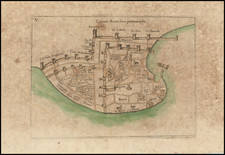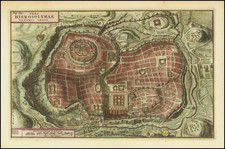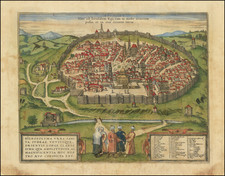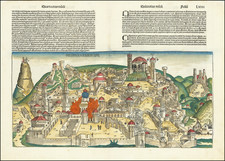Visscher’s Map of Jerusalem: A Vivid Depiction of the Sacred City Based Upon Genesis 14:18.
Visscher’s map of Jerusalem provides a finely detailed representation of the historical city, utilizing deep theological rendition. The title itself gives a hint to its religious leanings, referring directly to Genesis 14, verse 18, which talks about King Melchizedek of Salem, who was also a priest, bringing out bread and wine. Through his map, Visscher pays homage to the Biblical representation of Jerusalem and intertwines history with religious teachings.
A prominent feature that draws immediate attention is the scene of Solomon in the foreground. Solomon, regarded as one of Israel’s greatest kings, is renowned for his wisdom and the construction of the First Temple in Jerusalem. This depiction not only solidifies the importance of Jerusalem as the spiritual center of the Jewish faith but also reinforces its historical significance.
The map also notes the following places:
-
The Temple of Solomon: The First Temple, a central place of Jewish worship, built under King Solomon's directive.
-
Mount Zion: A hill in Jerusalem, often used synonymously with Jerusalem itself, especially in the context of its religious significance.
-
The Tower of David: Also known as the Jerusalem Citadel, this ancient fortress has significant historical and archaeological value.
-
Pool of Bethesda: The place where Jesus miraculously healed a paralyzed man.
-
The Tomb of King David: TA site traditionally believed to be the burial place of David, the second king of Israel.
-
Mount Moriah: The site where Abraham was set to sacrifice Isaac, and where Solomon's Temple was built.
-
The Western Wall: Also known as the Wailing Wall, it's a remnant of the Second Temple and a holy place of Jewish prayer.
-
Valley of Jehoshaphat: Associated with the final judgment in Christian and Jewish eschatology.
-
The Church of the Holy Sepulchre: A Christian site believed to be the location of Jesus' crucifixion and resurrection.
-
Garden of Gethsemane: Where Jesus prayed before his arrest, located at the foot of the Mount of Olives.
-
Pilate's Judgment Hall: The location where Jesus was tried by Pontius Pilate.
-
House of Caiaphas: The residence of the high priest Caiaphas, where Jesus was taken after his arrest.
-
Tombs of the Prophets: Burial sites traditionally associated with biblical prophets.
-
Pool of Siloam: The location where Jesus healed a blind man.
-
The Golden Gate: The eastern gate of the temple mount, believed by many to be the gate through which the Messiah will enter.
-
King Herod’s Palace: The royal palace of King Herod the Great.
-
The Antonia Fortress: A military barracks built by Herod the Great.
-
Pool of Hezekiah: A reservoir built to provide water to Jerusalem.
-
Via Dolorosa: The path Jesus is believed to have walked on his way to crucifixion.
-
Golgotha (Calvary): The site where Jesus was crucified.
-
The House of St. Mark: An ancient Christian house, believed to be one of Jerusalem's earliest churches.
-
Mount of Olives: A mountain range east of Jerusalem, frequently mentioned in the New Testament.
-
Tomb of the Virgin Mary: The traditional burial place of Mary, mother of Jesus.
-
Bethany: The village where Jesus raised Lazarus from the dead.
-
King Solomon’s Stables: Underground chambers that King Solomon is believed to have used as stables.
-
Pool of the Tower: An ancient reservoir.
-
Ophel: A biblical site south of the Temple Mount.
-
Nehemiah's Wall: A wall rebuilt by Nehemiah after the Babylonian exile.
-
Tomb of Zechariah: A monumental tomb associated with the prophet Zechariah.
-
Acra Fortress: A fortress built by the Seleucids to control Jerusalem.
-
City of David: The oldest settled neighborhood of Jerusalem and the historical core of the city.
-
Tomb of Absalom: A monumental rock-cut tomb associated with King David's rebellious son.
-
The Hinnom Valley: A valley associated with early pagan rituals and later identified with the concept of Gehenna or hell.
-
Kidron Valley: A valley on the eastern side of The Old City of Jerusalem, separating the Temple Mount from the Mount of Olives.
-
The Upper Room: The site where the Last Supper is believed to have taken place.
-
Tower of Hananel: A tower marking the northern boundary of ancient Jerusalem.
Visscher’s detailed illustration is not merely a map but a historical and religious tapestry of Jerusalem. By placing Solomon in the foreground and providing a key to 36 places, Visscher ensures that the viewer is transported to ancient Jerusalem, walking its streets, feeling its history, and appreciating its spiritual gravitas. The map serves as an artifact that bridges the gap between history, faith, and artistry, offering a holistic perspective on one of the world's most revered cities.










![[Jerusalem] Waerachtige beschryvinge vande wydvermaerde Conincklicke Hooft Stadt Ierusalem . . .](https://storage.googleapis.com/raremaps/img/small/96558.jpg)



![[Historical Time Line Map -- Creation To 100 AD] Tableau de L'Histoire Sainte Depuis La Creation du monde jusqu'a la dispersion du Juifs . . .](https://storage.googleapis.com/raremaps/img/small/82069.jpg)